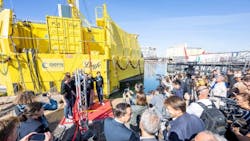Green hydrogen demonstrator starts sea trials off western France
Offshore staff
NANTES, France — Lhyfe has inaugurated its offshore renewable green hydrogen production demonstrator in Saint Nazaire, western France, said to be the first application worldwide of renewable hydrogen produced at sea.
The Sealhyfe platform is undergoing an 18-month experimental period, initially at the quay then off the coast of Le Croisic, on the offshore testing site (SEM-REV) operated by engineering school Centrale Nantes.
Lhyfe will produce the first kilograms of renewable green hydrogen at the quay and then at sea, operating automatically, in extreme conditions. The production unit is installed on a floating platform, connected to a floating wind turbine.
Challenges will include
- Performing all stages of hydrogen production at sea: converting the electrical voltage from the floating wind turbine, pumping, desalinating and purifying seawater, and breaking the water molecules via electrolysis to obtain renewable green hydrogen;
- Managing the effects on the system of the platform’s motion: list, accelerations, swinging movements;
- Withstanding environmental stress: Sealhyfe will have to survive the prematurely ageing of its parts from corrosion, impacts, temperature variations, etc.; and
- Operating in an isolated environment: the platform must operate fully automatically, without the physical intervention of an operator, except for scheduled maintenance periods (optimally integrated from the design phase).
Lhyfe has employed facilities at the offshore test site, SEMREV, operated by Centrale Nantes, for the project.
The production unit was installed on the WAVEGEM wave energy platform developed by Geps Techno.
At the end of the quayside test phase, the Sealhyfe platform will integrate the SEMREV offshore testing area, off the coast of Le Croisic, about 20 km from the coast, and the device will then be supplied with electricity by the floating wind turbine installed at the test site in 2018.
Plug Power supplied the electrolyzer, said to be the first capable of operating on a floating platform.
Others contributing to the development have been shipyard engineering group Chantiers de l’Atlantique, helping to bolster the resilience of the system to environmental stress, also working on the ventilation systems and the electrical architecture; GEPS Techno and EIFFAGE Energie Systems concerning integration of the Sealyhfe on a platform and the naval architecture of the latter, to withstand stormy sea condition; the Port of Saint-Nazaire, facilitator of Sealhyfe’s assembly and testing; and Kraken Subsea Solutions, which co-designed the underwater electrical connection to the renewable marine energies produced on the SEMREV platform.
The initial six-month trial phase will obtain reference measurements and test all the components (desalination and cooling systems, stack behavior, remote control, energy management, resistance to environmental conditions.
At the end of this first stage, Sealhyfe will be stationed for 12 months off the Atlantic coast, less than 1 km from the floating wind turbine, anchored to the seafloor and connected to the site’s underwater hub using an umbilical designed for this application for energy and data transfer)
At the end of the trial, the data complied should allow the design to be matured for future offshore production systems, with a view to deploying the technologies on a larger scale.
According to Lhyfe, Sealhyfe can produce up to 400 kg of renewable green hydrogen per day, equivalent to 1MW of power.
The development has had support from the French energy and environment agency ADEME and the Pays de la Loire Region.
BW Ideol is the floating wind asset owner, responsible for the day-to-day operations and maintenance.
09.23.2022
